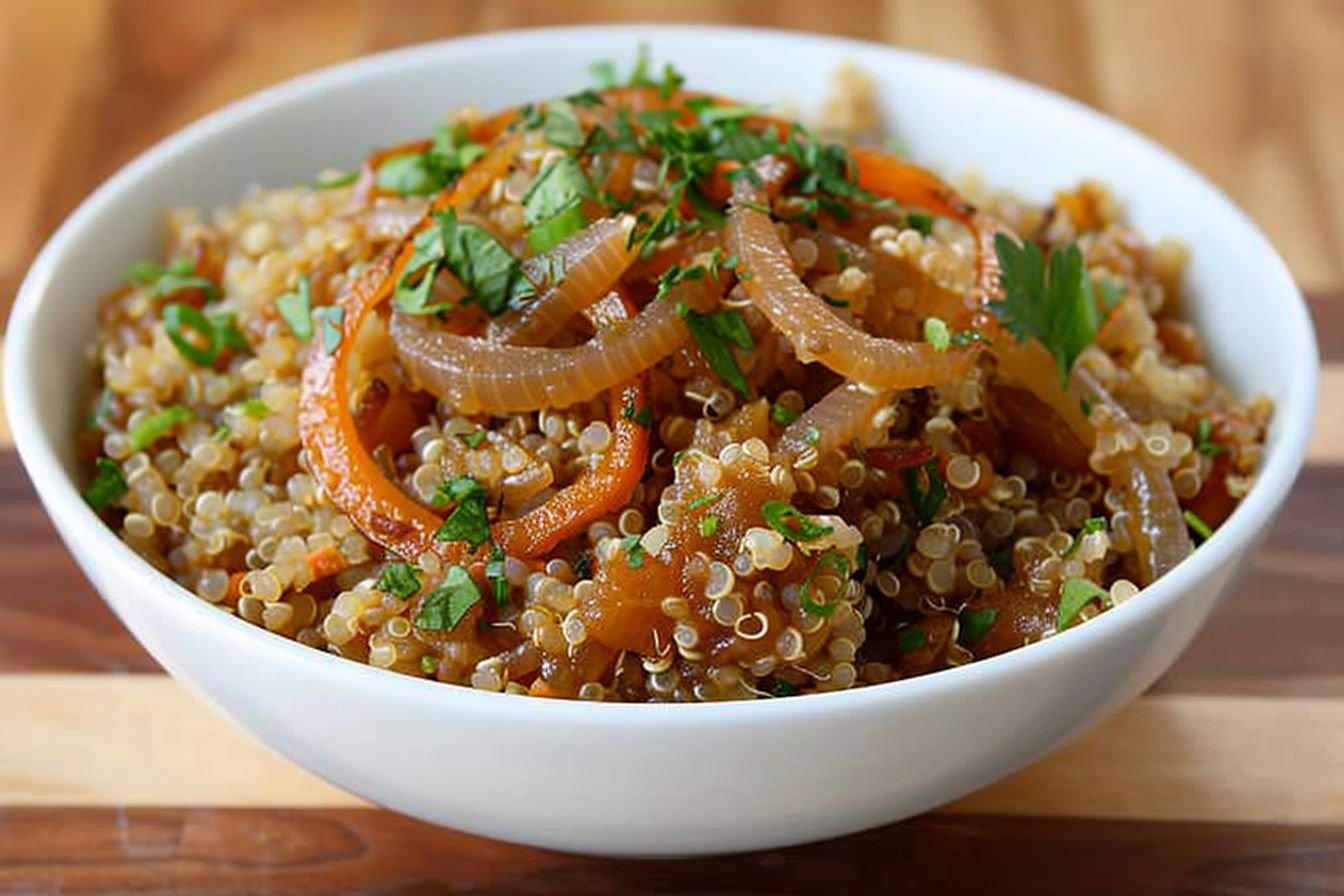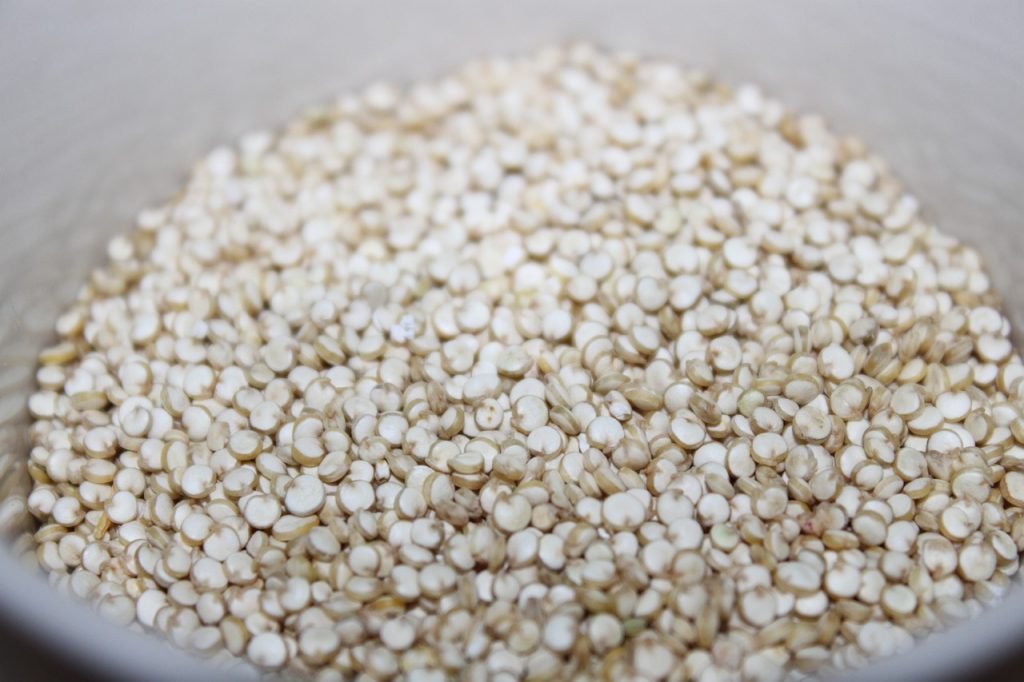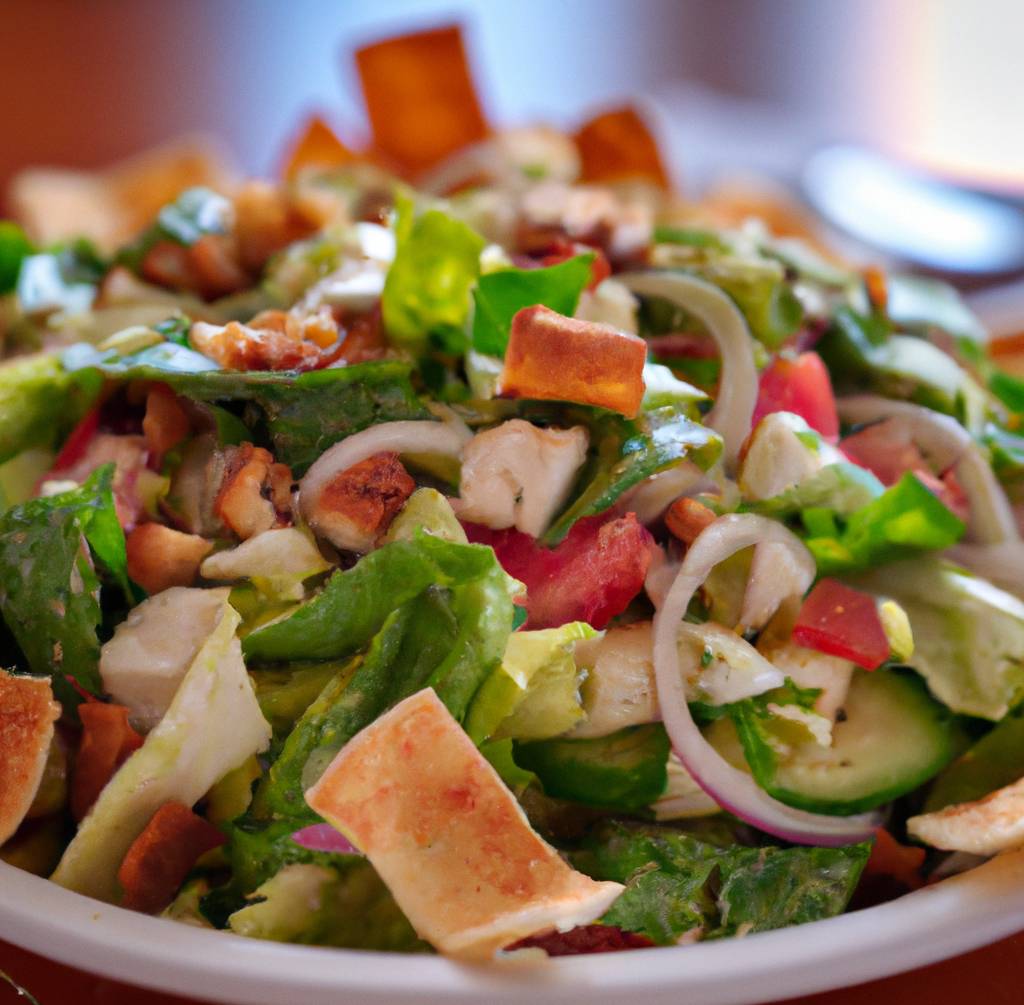Mujadara with Quinoa is a delicious and healthy combination of lentils, quinoa, and caramelized onions that is perfect for a cozy night in or a crowd-pleasing potluck dish.
To make it, you will need brown or green lentils, quinoa, extra virgin olive oil, cumin, bay leaves, lemon peel, onions, salt, pepper, and optional garnishes like fresh parsley or mint and Greek yogurt. The lentils and quinoa are cooked separately and then combined with the caramelized onions, which give the dish a sweet and savory flavor. The lemon peel adds a bright citrusy note, while the cumin and bay leaves add depth and warmth to the dish.
Origins of Mujadara
Historical Background
Mujadara is a traditional Middle Eastern dish that has been enjoyed for centuries. According to Wikipedia, the earliest known mujadara recipe is found in a 1226 cookbook from Iraq called Kitab al-Tabikh. It features rice, lentils, and meat, often served at celebrations.
It is unclear whether the Persians, who brought rice to western and central Asia from India, created the dish or borrowed it from India. However, it is widely believed that mujadara has been a staple dish in the Middle East for hundreds of years.
Cultural Significance
Mujadara is not just a dish, but a cultural symbol of the Middle East. The dish is often associated with poverty and simplicity, as it is made with inexpensive ingredients that are readily available in the region.
Despite its humble origins, mujadara has become a beloved dish in many Middle Eastern countries and is often served during holidays and special occasions. It is so popular that there are many different variations of the dish, each with its unique flavor and ingredients.
Quinoa as a Substitute
Benefits of Quinoa
Quinoa is a great substitute for traditional grains because it is a complete protein that contains all nine essential amino acids. It is also high in fiber, which can help you feel full and satisfied for longer periods. Quinoa is a good source of iron, magnesium, and phosphorus, which are important for maintaining healthy bones and muscles. Additionally, quinoa is low on the glycemic index, which means it won’t cause a rapid spike in blood sugar levels.
Quinoa vs. Traditional Grains
Quinoa has a slightly nutty flavor and a fluffy texture that makes it a great addition to salads, soups, and stews. It is also quick and easy to cook, taking only about 15 minutes to prepare. Unlike rice, quinoa doesn’t require a specific ratio of water to grain, making it less likely to become mushy or overcooked.
Ingredients:
- 1 cup of green or brown lentils
- 2 cups of quinoa
- 1/4 cup of extra virgin olive oil, divided
- 1 1/2 teaspoons of cumin
- 2 bay leaves
- 2 lemon peel strips, each around 2 inches in length.
- 2-3 chopped large onions
- Salt and pepper
- For garnish: chopped mint or fresh parsley
- For topping: greek yogurt
How to Make Mujadara with Quinoa?
Prep the lentils:
Give your lentils a good washing. Look for any pebbles or unwanted bits, then toss them out.
Put water on the stove and bring it to a rolling boil (4 cups will do). Season it with 2 teaspoons of salt. Add your rinsed lentils and simmer them for about 15 minutes. You want them tender but not mushy, so keep an eye on them!
Once cooked, drain the lentils and give them a quick rinse with cold water. Shake off any excess moisture.
Rinse and cook the quinoa:
Give your quinoa a good rinse under running water for a couple of minutes. A mesh strainer makes this easy.
In a large pot, heat some olive oil (2 tablespoons) until warm. Add your drained lentils, along with cumin, a sprinkle of salt (adjust based on your taste), and some pepper (1/2 teaspoon). Get them nice and hot, stirring for about 2 minutes.
Stir in your rinsed quinoa and turn the heat down to low.
Cook the lentils and quinoa together:
In the same pot, you cooked the lentils (rinsed out first!), heat some water (3 cups), and bring it to a boil.
Pour the boiling water over the lentils and quinoa into your other pot. Stir it all together and add a bay leaf and some lemon peel for extra flavor.
Bring everything to a boil, then cover the pot and simmer on low heat for about 20 minutes. Keep an eye on it – you want the water to be absorbed and the quinoa to be fluffy, with little tails showing. Once it’s done, let it sit covered for another 5 minutes.
Caramelize the onions:
- While the quinoa is simmering, grab another pan and heat some olive oil (2 tablespoons). Slice up an onion and add it to the pan. Cook it over medium heat until it softens and turns a beautiful golden brown (caramelized!).
Finishing touches:
Once the quinoa is done, remove the bay leaf and lemon peel. Fluff everything up with a fork.
Top your dish with the delicious caramelized onions and some fresh parsley or mint for a pop of color and flavor.
If you’re feeling fancy, add a dollop of Greek yogurt (for a non-vegan option). You can also swap the olive oil for melted butter
Serving Suggestions
1. Serve with a salad
A simple salad can be a great way to balance out the flavors of mujadara. A fresh green salad with cucumbers, tomatoes, and a tangy vinaigrette can be a perfect accompaniment to the hearty quinoa and lentil dish. You can also try a tabbouleh salad or a fattoush salad with lots of fresh herbs and a lemony dressing.
2. Add some protein
If you’re looking to make the meal more substantial, you can add some protein to the dish. Grilled chicken or lamb can be a great addition, as can some falafel or hummus. You can also try topping the mujadara with a fried egg for a tasty and satisfying breakfast or brunch option.
3. Serve with bread
Mujadara is traditionally served with pita bread, but you can also try serving it with other types of bread. A crusty baguette or some naan bread can be a great way to soak up the flavorful sauce and add some texture to the meal.
4. Roasted vegetables
Roasted vegetables are a great way to add some color and flavor to the dish. Try roasting some cauliflower, carrots, or sweet potatoes with some spices for a tasty and healthy side dish.
Nutritional Information
Quinoa is rich in protein, fiber, and essential amino acids. It is also loaded with magnesium, riboflavin, and phytonutrients. Eating it regularly can boost heart health, ease migraines, and lower cancer risk.
Lentils, the other main ingredient in mujadara, are also a fantastic source of protein and fiber. They’re also rich in iron, folate, and other essential vitamins and minerals. Lentils are low in fat and calories, making them a great food for weight loss.
When combined, quinoa and lentils make a complete protein, meaning they contain all nine essential amino acids that our bodies need but cannot produce on their own. This makes it an excellent choice for vegetarians and vegans.
In addition to quinoa and lentils, mujadara also contains caramelized onions, which are a great source of antioxidants and anti-inflammatory compounds. Caramelized onions are also low in calories and high in flavor, making them a great addition to any dish.
Customization Ideas
Vegetarian Variations
If you’re a vegetarian, you can still enjoy this dish by swapping the chicken broth (if using it instead of water) with vegetable broth. You can also add some roasted vegetables like sweet potatoes, carrots, or zucchini to add more flavor and nutrition to your meal. For a creamier texture, you can stir in some plain Greek yogurt or sour cream.
Adding Proteins
This mujadara is already a protein-rich dish, but if you want to add more protein to your meal, you can top it with some crumbled feta cheese or sliced avocado. You can also serve it with a side of grilled chicken or fish. For a vegan option, you can add some chickpeas or tofu.
Here are some other ideas for customizing your mujadara:
- Spices: Experiment with different spices like cinnamon, cardamom, or coriander to add more depth of flavor to your dish.
- Herbs: Fresh herbs like parsley, cilantro, or mint can add a refreshing touch to your mujadara.
- Nuts: Toasted nuts like almonds, walnuts, or pine nuts can add a nice crunch to your dish.
- Grains: Instead of quinoa, you can use other grains like brown rice, bulgur, or farro to make your mujadara.
Storage and Reheating
Once you’ve made a big batch of quinoa mujadara, you’ll want to store any leftovers properly to ensure they stay fresh and safe to eat. Here are some tips on how to store and reheat your quinoa mujadara:
Storage
- Store leftover quinoa mujadara in an airtight container in the fridge for up to 4 days.
- To prevent the onions from getting too soggy, store them separately from the quinoa and lentils.
- If you’ve added any toppings like yogurt or herbs, store them separately as well.
Reheating
- To reheat your quinoa mujadara, simply spoon the desired amount into a microwave-safe bowl and microwave on high for 1-2 minutes, or until heated through.
- Alternatively, you can reheat your quinoa mujadara on the stove. Add a splash of water or broth to help loosen it up and prevent it from sticking to the pan. Cook over medium heat, stirring occasionally, until heated through.
- If your quinoa mujadara seems a bit dry after reheating, you can add a drizzle of olive oil or a splash of broth to help moisten it up.
Common Mistakes
Using the wrong type of lentils
One of the most common mistakes people make when making mujadara is using the wrong type of lentils. Traditionally, mujadara is made with brown or green lentils, but some recipes call for red lentils. While red lentils cook faster, they tend to become mushy and lose their shape. Brown or green lentils hold up better and give the dish a nice texture.
Not caramelizing the onions enough
Caramelized onions are a key component of mujadara, and not caramelizing them enough can ruin the dish. It’s important to cook the onions slowly over low heat until they are deeply browned and sweet. This can take up to 45 minutes, but the result is worth it. If you’re short on time, you can use a food processor to slice the onions thinly and evenly, which will speed up the caramelization process.
Overcooking the quinoa
Quinoa cooks quickly, and it’s easy to overcook it. Overcooked quinoa can become mushy and lose its texture. To avoid this, be sure to rinse the quinoa thoroughly before cooking it and use the correct ratio of water to quinoa. Generally, you should use 2 cups of water for every 1 cup of quinoa. Bring the water to a boil, add the quinoa, reduce the heat, and let it simmer for 15-20 minutes, or until the water is absorbed and the quinoa is tender.
Conclusion
In conclusion, mujadara with quinoa is a delicious and healthy twist on the traditional Middle Eastern dish. By substituting quinoa for rice, you can increase the protein and fiber content of the dish while still enjoying the rich and savory flavors of caramelized onions and lentils.
One of the great things about this dish is how versatile it is. You can enjoy it as a side dish with grilled chicken or fish or as a main course with a side of fresh vegetables. It’s also perfect for meal prep, as it can be stored in the fridge for several days and reheated easily.
When making it, be sure to take your time caramelizing the onions. This is what gives the dish its rich and complex flavor. You can also experiment with different spices and herbs to add your unique twist to the recipe.
Overall, mujadara with quinoa is a nutritious and delicious dish that is easy to make and perfect for any occasion. Give it a try and see for yourself how tasty and satisfying it can be!
As mentioned above, fattoush salad is a great accompaniment for this mujadara.
Get the recipe now (by clicking the image below):






